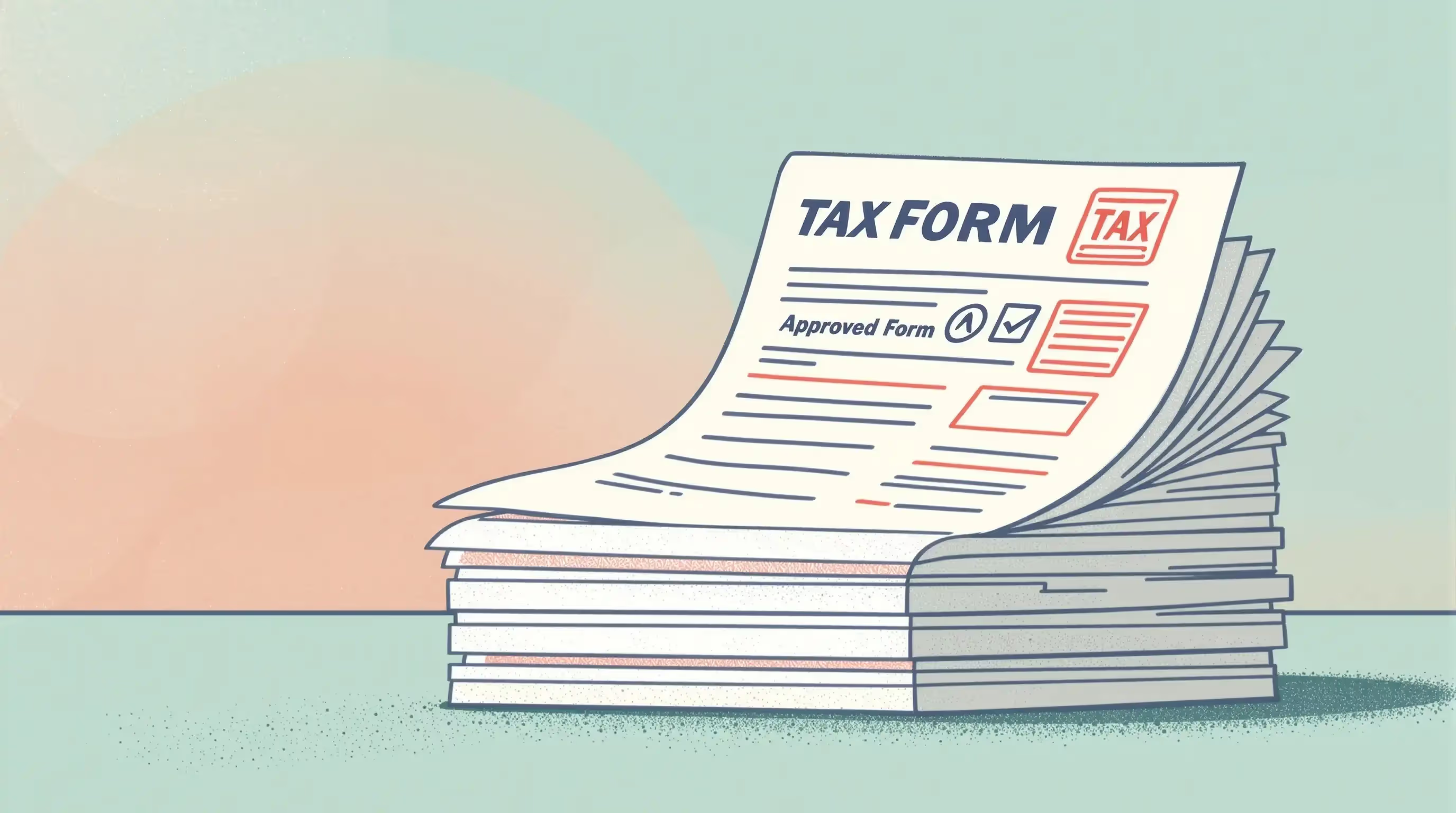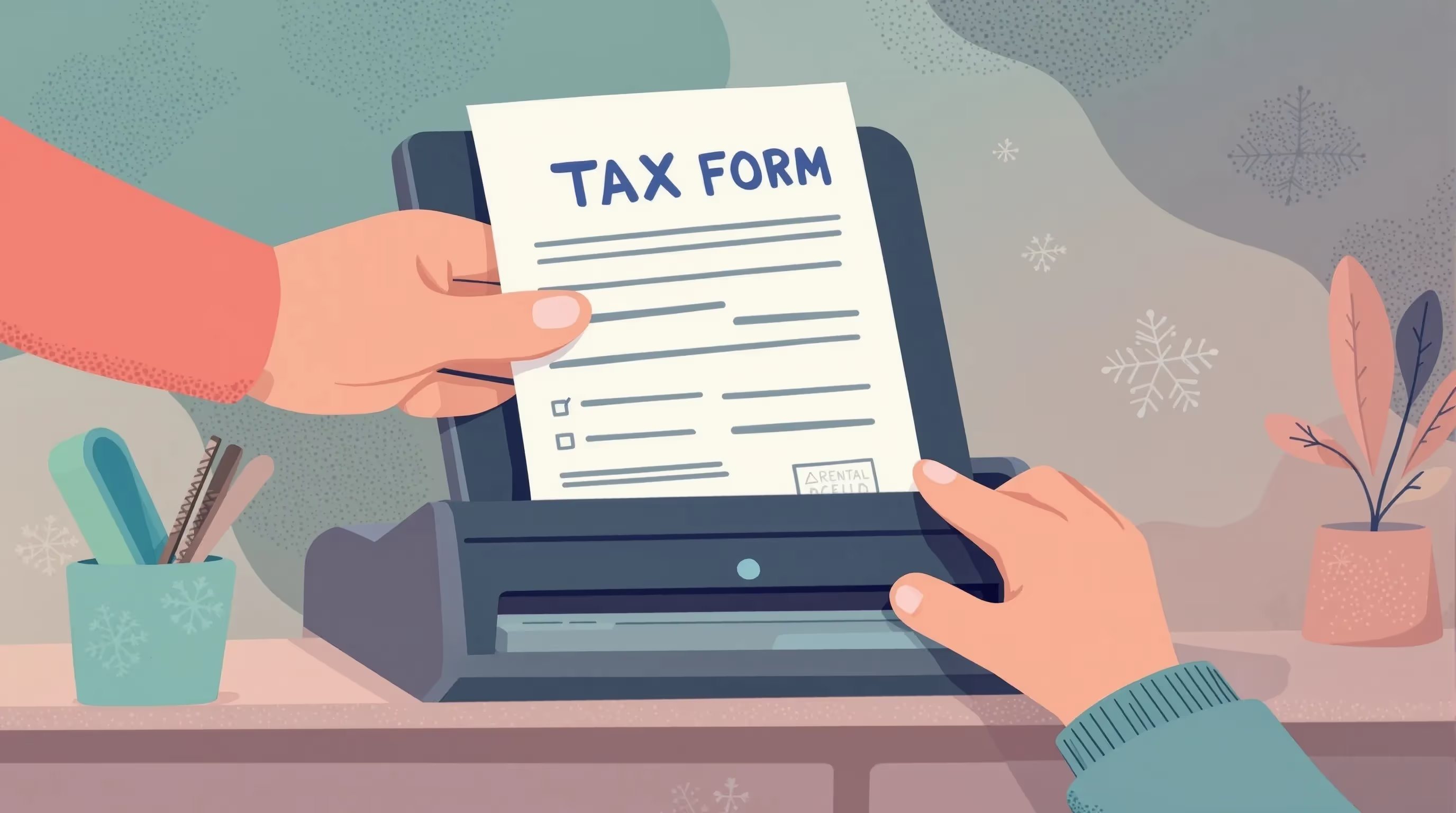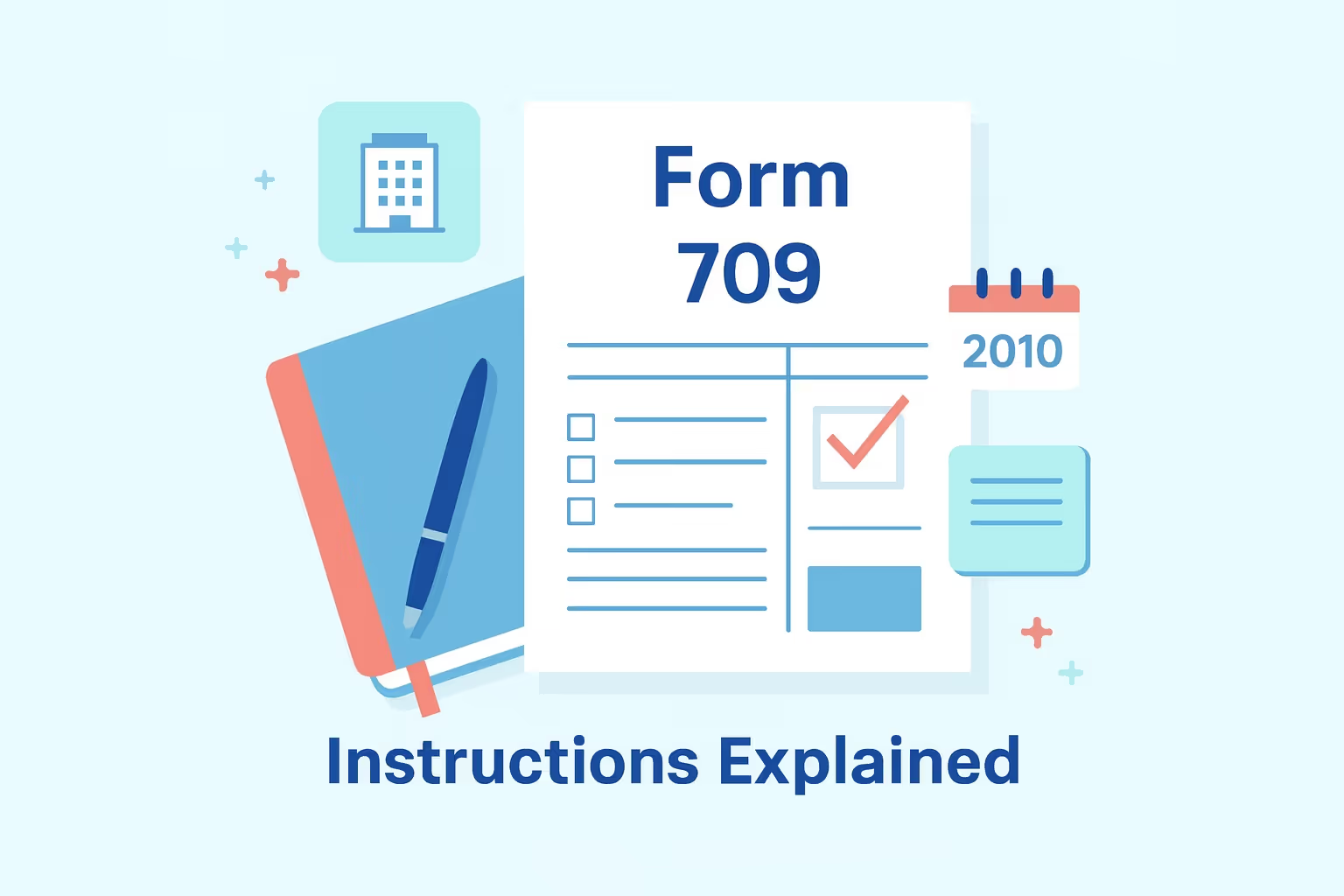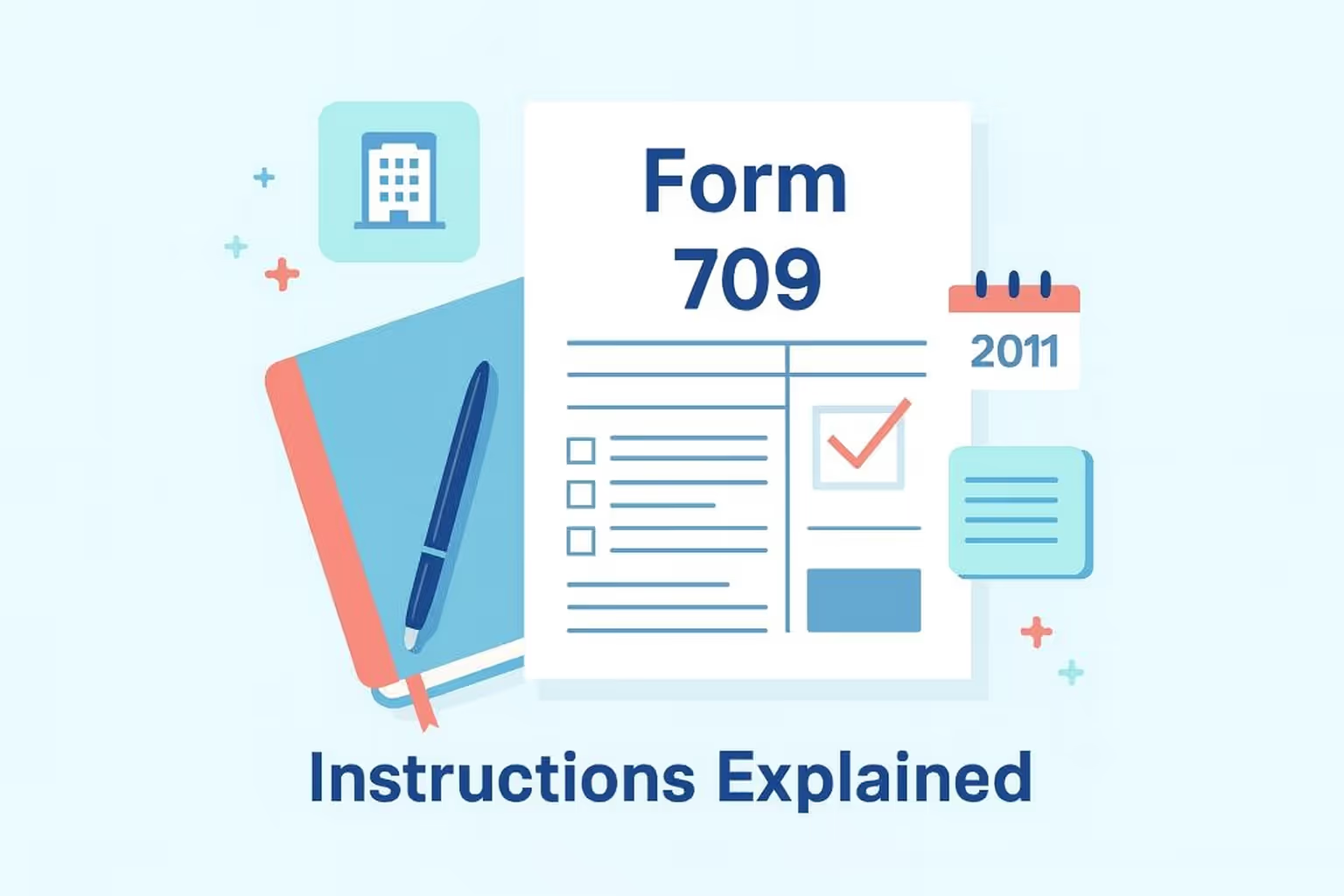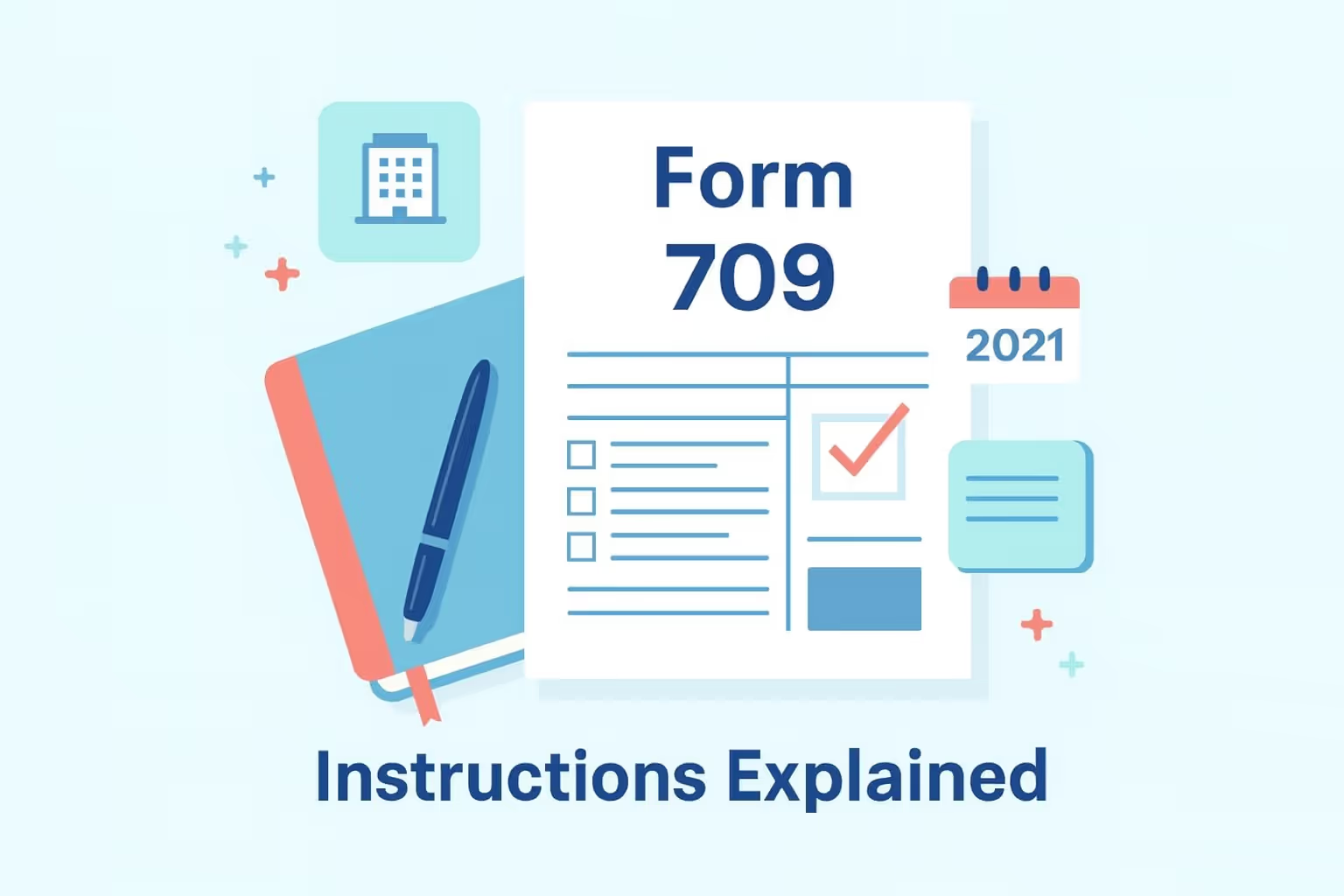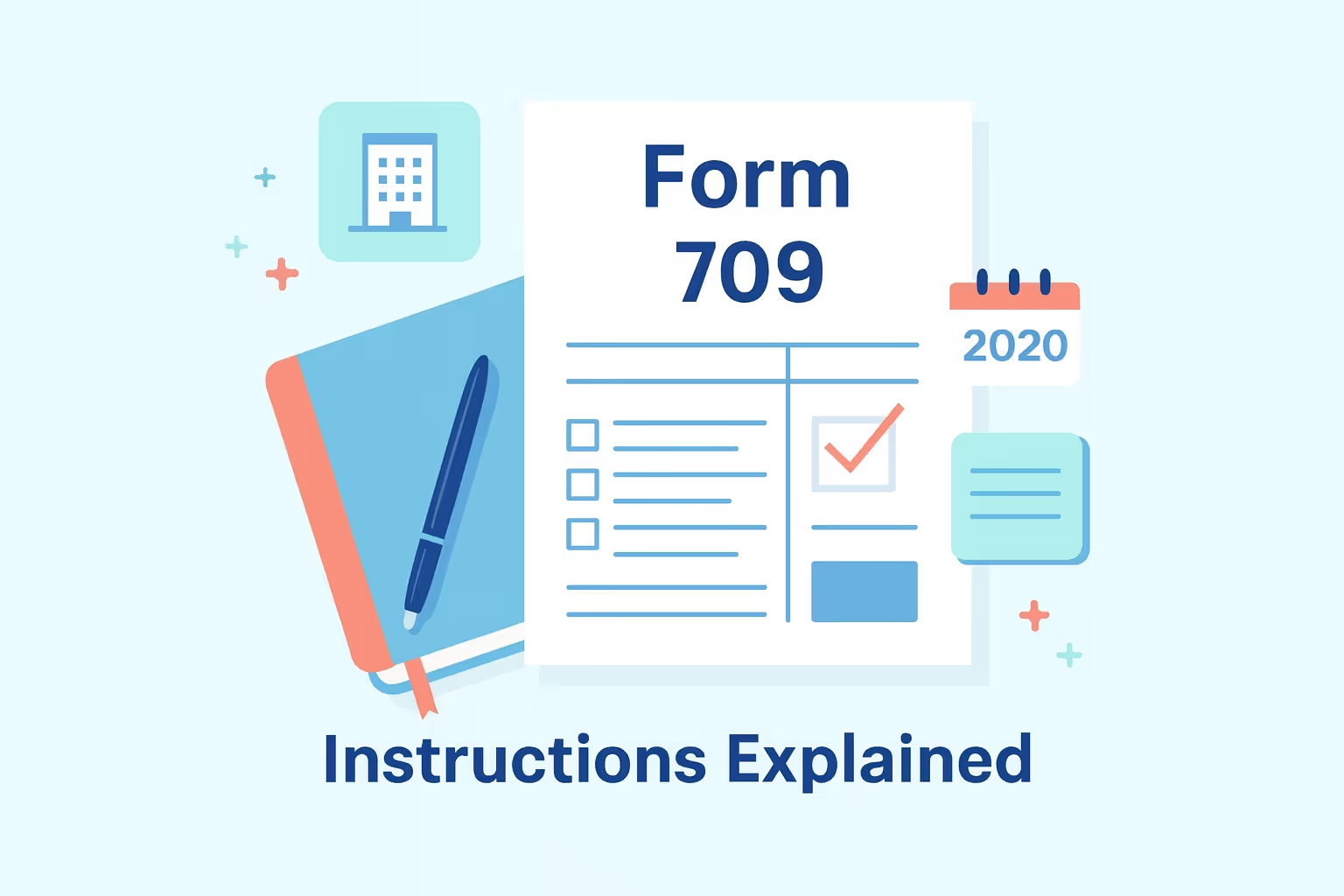Guide to Form 709 2022 Instructions for Gift Tax Filing
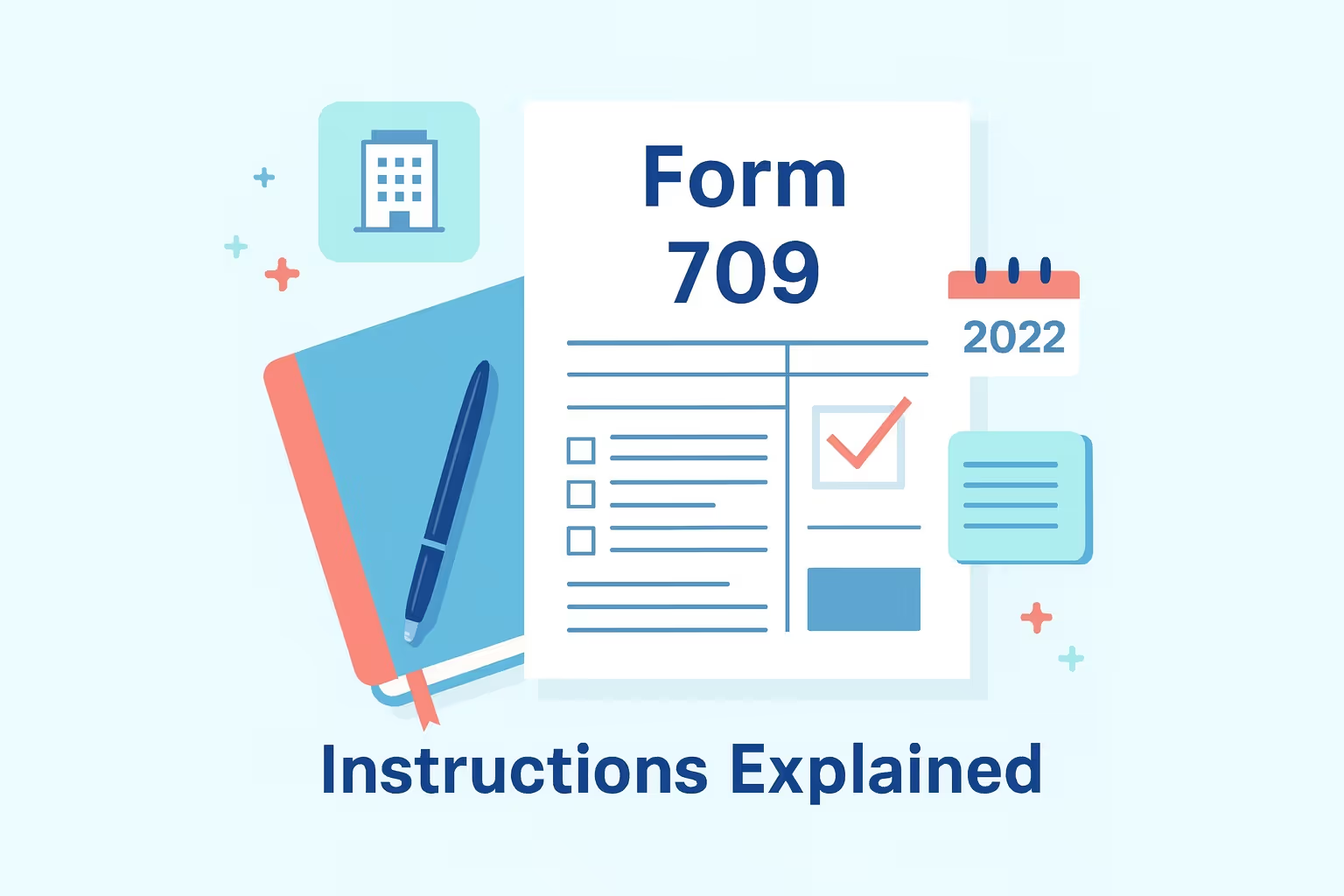
The Guide to Form 709 2022 Instructions for Gift Tax Filing helps you understand how to report gifts made during the 2022 tax year. Form 709, officially called the United States Gift (and Generation-Skipping Transfer) Tax Return, reports gifts that exceed the annual exclusion or involve complex transfers such as trusts or future interests. The Internal Revenue Service (IRS) requires this form to accurately track each taxpayer’s lifetime gift and estate tax exemption. You can find the official form and filing details directly on IRS.gov.
For gifts made during the calendar year 2022, the filing deadline was April 15, 2023, with an automatic six-month extension if you filed Form 8892 or Form 4868. You must file Form 709 if you gave more than $16,000 to any one person (apart from your spouse) or made gifts of future interest, regardless of the amount. Filing ensures your transfers are correctly recorded and helps you apply the correct annual gift tax exclusion and lifetime gift tax exemption limits.
This guide simplifies the federal gift tax process for individuals new to these rules. You’ll learn who must file, how to determine reportable gifts accurately, and the steps to complete and submit Form 709. It also covers payment methods, filing options, and recent IRS updates affecting digital assets and electronic submissions. Whether you’re planning gifts to family members, trusts, or other recipients, following these 2022 Form 709 instructions will help you stay compliant, avoid penalties, and keep your records for future estate planning.
Understanding Federal Form 709 and Gift Tax Basics
Form 709, titled United States Gift (and Generation-Skipping Transfer) Tax Return, is the federal document that reports certain gifts made during the year. It ensures the Internal Revenue Service (IRS) can accurately track taxpayers' taxable gifts, lifetime gift tax exemption, and estate tax exemption. The form also helps the IRS coordinate gift and estate tax records to prevent double taxation. You can review the official form and its instructions on IRS.gov.
Purpose of Form 709
Form 709 serves several essential purposes. It reports gifts that exceed the annual gift tax exclusion and allows married couples to elect gift splitting, which lets each spouse treat half of a shared gift as their own. The form also records generation-skipping transfers (GST) to grandchildren or trusts and tracks using a filer’s lifetime gift tax exemption, which was $12.06 million for 2022.
When You Must File
Taxpayers must file Form 709 if they made gifts exceeding $16,000 to any one person during 2022, gave a future interest gift through a trust, or made community property gifts requiring shared reporting. Filers must also submit the form when they elect to split gifts with a spouse.
Gifts Not Requiring Form 709
Certain transfers do not require filing. Payments made directly for tuition or medical expenses, gifts to qualifying charities or political organizations, and transfers to a U.S. citizen spouse are excluded from reporting requirements.
Understanding these rules helps taxpayers identify which gifts made in 2022 qualify as reportable under federal gift tax law and ensures compliance with the IRS’s gift tax filing standards.
What’s New for Tax Year 2022
For 2022, the IRS introduced several updates that affect how taxpayers file Form 709 and report taxable gifts:
- Annual Gift Tax Exclusion: The limit increased from $15,000 to $16,000 per recipient, allowing larger gifts without triggering a filing requirement.
- Lifetime Gift Tax Exemption: The exemption rose to $12.06 million, giving taxpayers more flexibility for lifetime transfers.
- Non-Citizen Spouse Exclusion: The exclusion amount increased to $164,000, offering greater allowance for gifts to non-U.S. citizen spouses.
- Digital Asset Reporting: The IRS clarified that cryptocurrencies, NFTs, and other digital assets must be reported at their fair market value on the gift date.
- Electronic Filing Expansion: The Modernized e-File (MeF) system now accepts gift and estate tax returns, offering faster and more secure submission.
Step-by-Step Instructions for Completing Form 709
Completing Form 709 requires accuracy and organization to report every taxable gift properly. These steps outline how to prepare documentation, identify which gifts must be included, calculate accurate values, and complete each federal gift tax form section following IRS Form 709 2022 instructions.
Step 1: Gather Required Information
Start by collecting all records of gifts made during the 2022 calendar year. Preparing these materials in advance helps ensure accuracy and reduces the chance of missing important details. Each filer should have a complete set of documents before starting the Form 709 process.
Every taxpayer filing Form 709 should include:
- Their full legal name, Social Security Number, and current mailing address are listed exactly as they appear on their income tax return.
- The names, addresses, and taxpayer identification numbers of each gift recipient.
- Detailed descriptions and fair market values of every gift based on the date of transfer.
- For consistency in reporting, copies of any previously filed Form 709 returns, if applicable, are to be maintained.
- Supporting records such as appraisals, legal agreements, or financial statements that verify the value of each gift.
- Documentation confirming any gift-splitting election if the filer and spouse have agreed to divide gifts for tax purposes.
- Information showing prior lifetime exemption usage or a deceased spouse’s unused exclusion (DSUE) amount.
Keeping these materials organized ensures that each return section is completed accurately and that the filer complies with gift tax reporting requirements.
Step 2: Determine Which Gifts Are Reportable
Not all transfers must be included on Form 709. The Internal Revenue Service (IRS) requires filing only when specific thresholds or conditions are met. Understanding these distinctions is essential for accurate reporting.
Gifts that must be reported include:
- Any transfer of money or property that exceeds $16,000 to a single recipient during 2022.
- Future interest gifts, such as transfers held in trusts or restricted until a future date.
- Assets transferred to trusts or other entities that limit the recipient’s immediate access.
- Community property gifts made in states that recognize shared marital ownership.
- Digital assets, including cryptocurrencies, stablecoins, or non-fungible tokens (NFTs).
Gifts that do not require reporting include:
- Transfers valued at $16,000 or less to any recipient during the 2022 tax year.
- Payments made directly to educational or medical institutions on behalf of another person.
- Contributions to qualifying charitable organizations or recognized political groups.
- Property transferred to a U.S. citizen spouse who qualifies for the marital deduction.
By distinguishing between reportable and nonreportable gifts, taxpayers can file accurately, avoid penalties, and maintain proper documentation for future gift and estate tax reporting.
Step 3: Calculate Gift Values Correctly
Each item reported on Form 709 must reflect its fair market value as of the date the gift was transferred. The IRS provides clear guidance on determining accurate valuations for different types of assets.
- Cash gifts should report the exact dollar amount given at the time of transfer.
- Securities must use the closing market price recorded when the gift was made.
- Real estate should include a professional appraisal that verifies its current market value.
- Digital assets, such as cryptocurrency or NFTs, must be valued using reliable and recognized exchange data.
- Business interests require certified valuation documentation prepared by a qualified professional.
Using precise valuations helps taxpayers maintain compliance, avoid audit issues, and ensure consistency with federal gift and estate tax regulations.
Step 4: Complete Each Section of Form 709
The form consists of multiple parts that determine overall tax liability.
- Part 1 – General Information: Enter personal details, marital status, and gift-splitting elections. Provide explanations for unusual transactions when necessary.
- Part 2 – Tax Computation: Calculate total taxable gifts, subtract exclusions, and determine any balance owed using the federal gift tax rate.
- Schedules A through D – Supporting Information:
- Schedule A lists gifts subject to gift tax, including cash, property, and digital transfers.
- Schedule B summarizes prior gifts and lifetime exemption usage.
- Schedule C records any Deceased Spousal Unused Exclusion (DSUE).
- Schedule D covers generation-skipping transfer (GST) taxes related to grandchildren or trusts.
- Schedule A lists gifts subject to gift tax, including cash, property, and digital transfers.
Complete all schedules before finalizing Part 2, since totals from these pages feed directly into the main tax computation. A well-organized, accurate return supports future estate planning and maintains compliance with federal gift and GST tax laws.
How to File Form 709—E-File and Paper Options
The Internal Revenue Service (IRS) allows taxpayers to file Form 709 electronically or by paper, depending on their preference and eligibility. Choosing the correct method ensures the timely submission and processing of your federal gift tax return.
Electronic Filing (Modernized e-File System)
The IRS now accepts Form 709 through its Modernized e-File (MeF) system. This option offers a faster, more secure way to submit returns while reducing the risk of errors. Electronic filing provides several advantages:
- It allows immediate confirmation that the IRS has received and accepted the return.
- Automated checks help identify missing data or miscalculations before submission.
- Taxpayers can make payments electronically using Electronic Funds Withdrawal (EFW) or the Electronic Federal Tax Payment System (EFTPS).
- Sensitive information is transmitted securely, minimizing the chance of mailing delays or misplaced documents.
Taxpayers can authorize an IRS-approved e-file provider or use compliant software to file electronically. Review all uploaded documents and retain the confirmation receipt for personal records. is important
Paper Filing Option
Some taxpayers prefer mailing their Form 709, or may not qualify for electronic filing. Paper submission remains accepted when completed correctly and sent to the mailing address designated for the filer’s state of residence.
Before sending the return, taxpayers should carefully complete the following checklist:
- Sign and date the form to validate the filing.
- Attach all required schedules and supporting documents to ensure accuracy.
- Include copies of prior-year Form 709 returns if they are relevant to the current filing.
- Retain a complete copy of the return and all attachments for personal or professional records.
- Mail the return using a secure or trackable delivery method to confirm receipt.
Completing these steps thoroughly helps ensure timely acknowledgment and compliance with federal gift tax reporting requirements.
Paying Gift Tax—Methods and Deadlines
When Form 709 is filed, payment may be required if the total taxable gifts exceed the available lifetime exemption. For tax year 2022, the exemption amount is $12.06 million, which covers the combined value of lifetime and estate transfers. A federal gift tax payment becomes necessary if the total taxable gifts exceed this limit.
Accepted Payment Methods
Taxpayers have several secure options to pay any balance due:
- Electronic Funds Withdrawal (EFW): This option allows the IRS to withdraw payment directly from a bank account when the return is filed electronically.
- Electronic Federal Tax Payment System (EFTPS): Through the federal portal, taxpayers can schedule and make payments online.
- Direct Pay: Payments can be made directly from a checking or savings account through the IRS payment system.
- Credit or Debit Card: The IRS accepts payments through authorized processors, though convenience fees may apply.
- Check or Money Order: Taxpayers filing by mail may submit payments made payable to the “United States Treasury.”
Payment Deadlines
For 2022 filings, payment is due by April 15, 2023. Even if an extension to the filing is granted, the deadline to pay remains the same. Failing to pay on time can result in interest charges and penalties.
Taxpayers unable to pay in full may contact the IRS directly to request an installment agreement. Making timely payments helps maintain compliance and prevents unnecessary fees or enforcement actions.
Required Schedules and Attachments
Form 709 includes several schedules that provide detailed information about the gifts made during the tax year. Completing each schedule accurately ensures proper calculation of your gift tax and, if applicable, your generation-skipping transfer (GST) tax.
Schedules Overview
Each schedule serves a specific purpose within the federal gift tax return:
- Schedule A – Computation of Taxable Gifts: Used to list all direct gifts to individuals and calculate total taxable amounts. It includes sections for present and future interest gifts and applies annual exclusions.
- Schedule B – Gifts from Prior Periods: Summarizes previously reported gifts and tracks cumulative lifetime exemption use.
- Schedule C – Deceased Spousal Unused Exclusion (DSUE): Completed when a surviving spouse applies an unused exemption amount from a deceased spouse’s estate.
- Schedule D – Generation-Skipping Transfer Tax: Used to report transfers to grandchildren or trusts that skip one or more generations.
Supporting Attachments
Additional documentation may be required to verify the value of gifts and to support any deductions claimed on Form 709. Taxpayers should include the following materials when applicable:
- Appraisals that confirm the fair market value of real estate or high-value personal property.
- Trust agreements or partnership documents that provide evidence for complex or shared ownership transfers.
- Financial statements that substantiate the fair market value of securities, business interests, or other assets.
- Proof of charitable contributions that support any deductions reported on the return.
Providing clear and accurate documentation helps ensure the IRS can verify reported information and process the return without delay.
Common Mistakes to Avoid When Filing Form 709
Filing Form 709 requires careful attention to detail. Even small mistakes can lead to penalties, delayed processing, or incorrect gift tax calculations. Understanding common errors helps taxpayers avoid issues and comply with IRS reporting requirements.
Frequent Filing Errors
- Omitting a required return when gift splitting is elected: Both spouses must file separate Form 709 returns, even if no tax is due.
- Failing to report gifts of future interest: Gifts with delayed ownership or restricted access must always be included, regardless of their value.
- Using the wrong valuation date: The IRS requires taxpayers to use the fair market value on the date the gift was made, not its current or purchase value.
- Forgetting to include supporting documents: Missing appraisals, trust agreements, or prior Form 709 filings can cause processing delays.
- Misapplying the annual exclusion: The $16,000 limit applies per recipient, not per gift, and does not cover future interest transfers.
- Leaving sections incomplete: Missing signatures, dates, or totals in the computation sections may result in an unprocessed or rejected return.
Avoiding These Errors
Before submitting the return, review all schedules, attachments, and calculations for consistency. Confirm that every required line is completed, and ensure each reported gift matches its documentation. Keeping organized records and reviewing the IRS Form 709 instructions annually helps maintain compliance and prevent unnecessary corrections or penalties.
Recordkeeping and Inactive Years
Even in years when Form 709 does not need to be filed, maintaining complete and accurate records of gifts is essential for long-term tax and estate planning. Proper documentation supports future filings and helps track how much of the lifetime exemption has already been used.
When Filing Is Not Required
Taxpayers are not required to file Form 709 under certain circumstances. A return is unnecessary when all transfers fall within the annual exclusion and meet IRS requirements for tax-free gifts.
A filing is not required in the following situations:
- Each gift made during the year was $16,000 or less and given to a single recipient.
- Every transfer qualified as a present interest gift, allowing the recipient immediate use and enjoyment of the asset.
- No gift-splitting election was made between spouses for that tax year.
- All payments were made directly to educational or medical institutions to cover qualified expenses for another individual.
Understanding these exceptions helps taxpayers determine whether a filing is necessary and prevents unnecessary submission of Form 709.
Why Recordkeeping Matters
Maintaining detailed records helps taxpayers track how much of their lifetime gift tax exemption has been used and verify prior transfers when preparing future returns. Each record should contain enough information to ensure accuracy and compliance with IRS reporting requirements.
Every record should clearly include the following details:
- The date each gift was made and the total amount given during the year.
- The recipient’s full name and their relationship to the donor.
- Reliable documentation verifying the valuation supports the gift's fair market value on the date of transfer.
Keeping organized, complete records allows taxpayers to substantiate reported amounts, prevent filing errors, and streamline future gift tax submissions.
Annual Planning Tip
Review all gifts at the end of each year. Keeping consistent records helps ensure accuracy in future gift tax filings and prevents missed reporting obligations.
First-Time Filer Tips and Professional Guidance
Filing Form 709 for the first time can seem overwhelming, but it becomes much easier to manage with proper preparation. Understanding when the gift tax applies and what documentation is required for gift tax purposes helps ensure a smooth filing process and full compliance with IRS rules.
Key Tips for New Filers
First-time filers should keep the following points in mind:
- The annual gift tax limit for 2022 was $16,000 per recipient. Gifts below this yearly exclusion amount are generally considered tax-free and do not require reporting.
- When giving only a partial interest in an asset, such as property or a business share, the transfer must be reported on Form 709 even if its value falls below the annual threshold.
- The IRS does not permit a joint gift tax return, but married couples can elect to split gifts on separate filings. This election effectively doubles the gift tax limit per recipient for that tax year.
- Always keep supporting documents, including valuations and prior filings, for future reference and verification.
Professional Guidance and Payment Considerations
Before completing the return, review your individual income tax return to ensure all personal information matches. If any amount of tax is due, you must file a gift tax return and pay taxes by the April filing deadline to avoid interest or penalties.
Consulting a qualified tax professional can help ensure accuracy, maximize available exclusions, and simplify the process for those new to filing gift tax returns.
Conclusion
Filing Form 709 plays an essential role in long-term tax and estate planning. For the 2022 tax year, updates such as the higher annual exclusion amount, new reporting rules for digital assets, and expanded e-filing options highlight the importance of understanding current IRS requirements before submitting your gift tax return.
Accurate recordkeeping and proper documentation are key to avoiding errors, penalties, and unnecessary delays. Each filer should review their information carefully, confirm fair market values, and attach all required schedules and supporting documents. Doing so helps ensure that every gift tax filing aligns with federal regulations and reflects complete, verifiable information.
When questions arise, working with a qualified tax professional is the best way to stay compliant. Professional advice helps clarify how gift tax laws apply to your situation and ensures all filing and payment steps are handled correctly and on time.
Frequently Asked Questions (FAQ)
Can my spouse and I file a joint Form 709?
No, the IRS does not allow a joint gift tax return, but you may elect to split gifts to your spouse. This election lets each spouse use their annual exclusion, doubling the total gift tax limit for a single recipient. Each spouse must still file Form 709 to document their transfer share.
How do I report cryptocurrency or digital asset gifts?
Digital assets, including cryptocurrency and NFTs, must be listed on Schedule A at their fair market value on the date of transfer. Supporting records, such as exchange statements, should be included with the filing. These items are treated as taxable gifts and must be reported when their value exceeds the annual exclusion set by the IRS.
What happens if I file Form 709 late?
Late filing may result in penalties and interest. The IRS generally charges a 5% monthly penalty on unpaid tax, up to 25% of the total owed. If taxes apply, interest accrues from the due date. Filing promptly helps avoid these costs and ensures accurate reporting of gift and GST taxes for the year.
Can I amend a previously filed Form 709?
You may file an amended return by completing a new Form 709 and checking the “Amended Return” box. Include a clear explanation of the correction and provide revised documentation. Amending ensures that your records accurately reflect prior gifts and remain consistent with IRS requirements for gift and estate tax reporting.
How long should I keep copies of Form 709 and supporting documents?
You should keep copies of Form 709 and related attachments permanently. These records verify prior generation skipping transfer allocations, support the accuracy of the gift tax rate applied, and confirm past use of the gift tax exclusion. Maintaining detailed files protects your records for future filings and helps avoid confusion during estate tax review.







